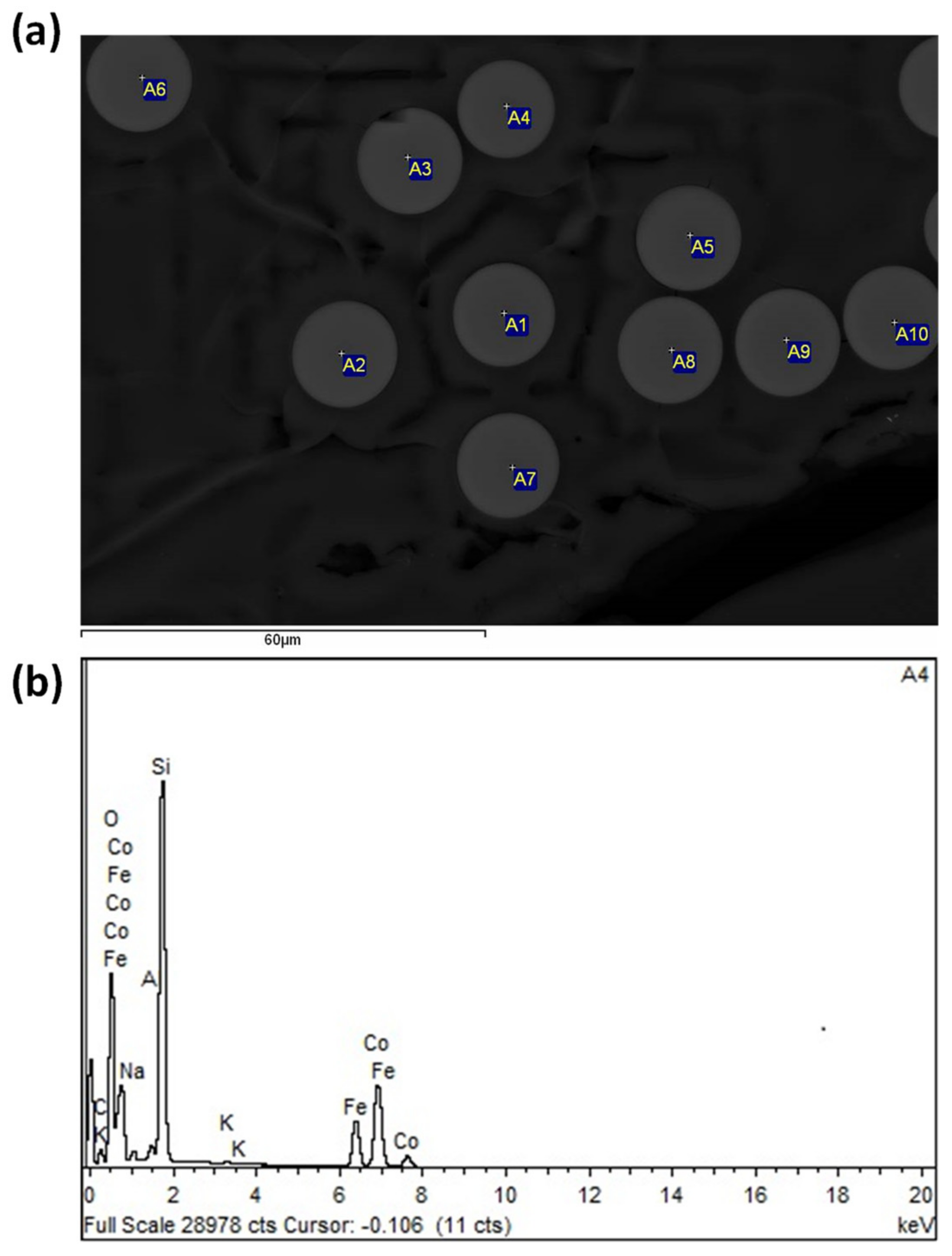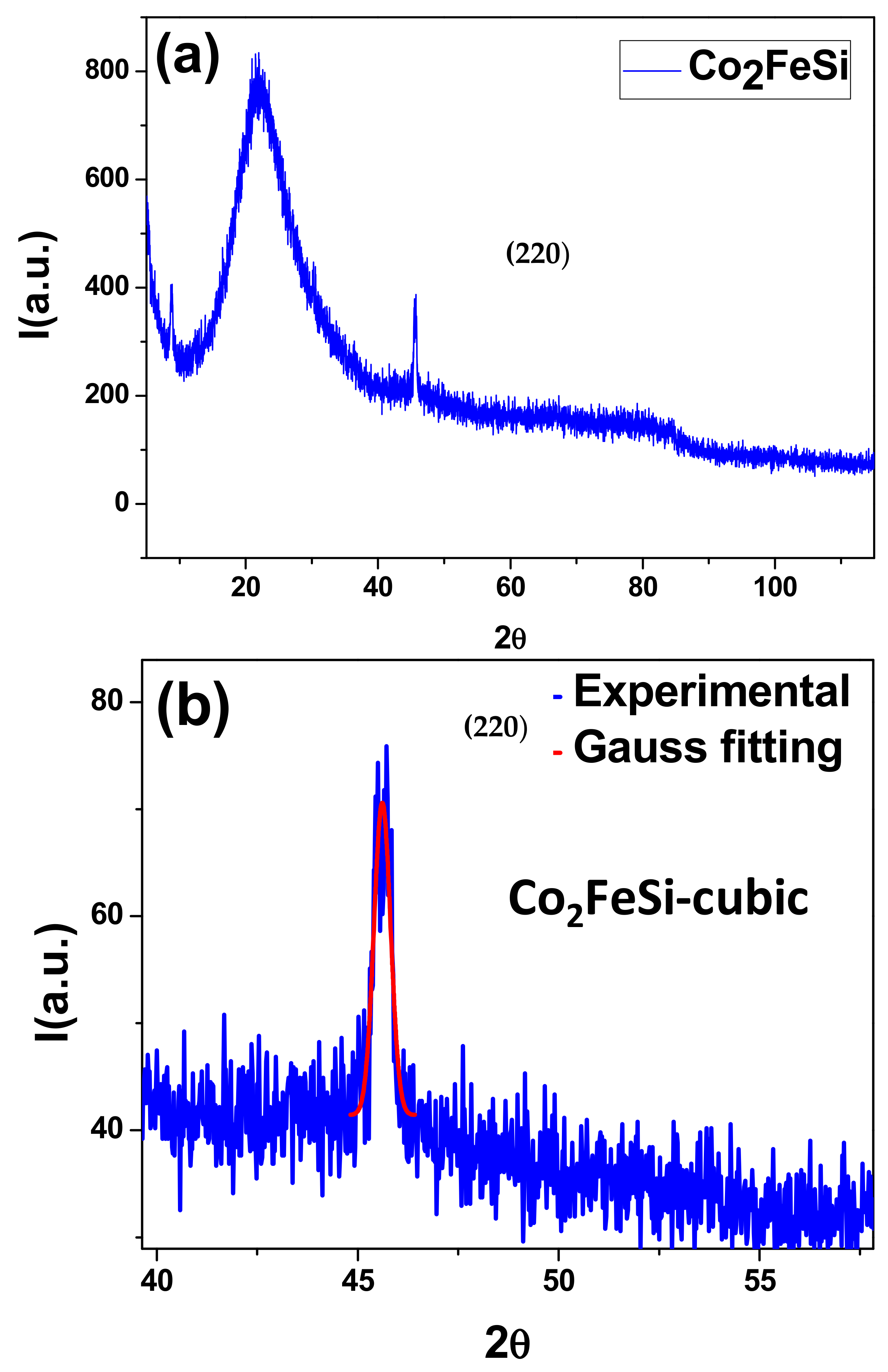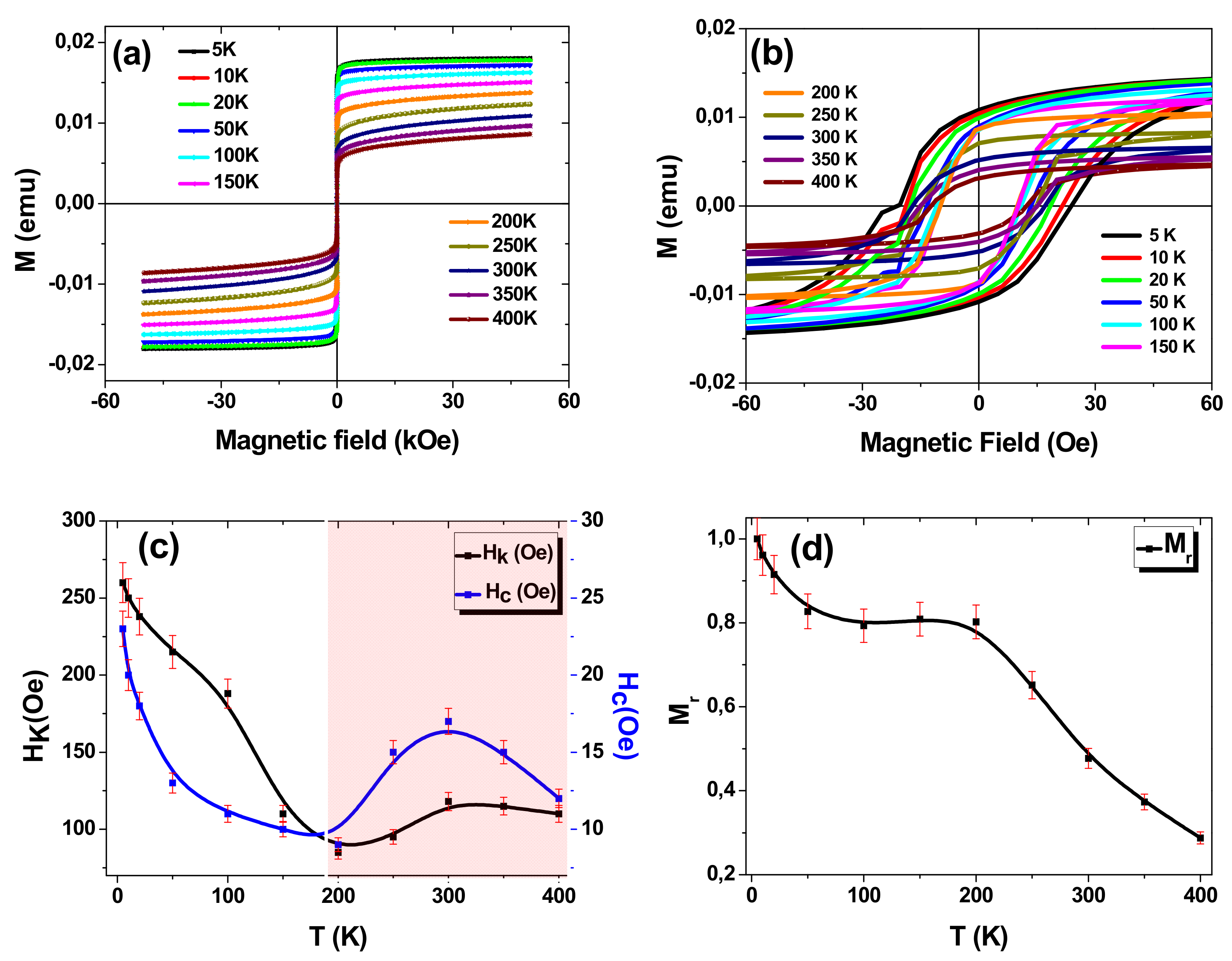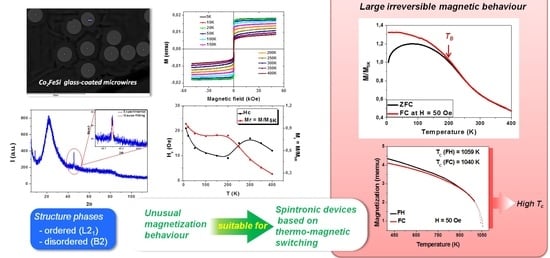Fabrication and Magneto-Structural Properties of Co2-Based Heusler Alloy Glass-Coated Microwires with High Curie Temperature
Abstract
:1. Introduction
2. Materials and Methods
3. Results and Discussion
4. Conclusions
Author Contributions
Funding
Institutional Review Board Statement
Informed Consent Statement
Data Availability Statement
Acknowledgments
Conflicts of Interest
References
- Li, P.; Koo, J.; Ning, W.; Li, J.; Miao, L.; Min, L.; Zhu, Y.; Wang, Y.; Alem, N.; Liu, C.X.; et al. Giant Room Temperature Anomalous Hall Effect and Tunable Topology in a Ferromagnetic Topological Semimetal Co2MnAl. Nat. Commun. 2020, 11, 3476. [Google Scholar] [CrossRef] [PubMed]
- Belopolski, I.; Manna, K.; Sanchez, D.S.; Chang, G.; Ernst, B.; Yin, J.; Zhang, S.S.; Cochran, T.; Shumiya, N.; Zheng, H.; et al. Discovery of Topological Weyl Fermion Lines and Drumhead Surface States in a Room Temperature Magnet. Science 2019, 365, 1278–1281. [Google Scholar] [CrossRef] [PubMed] [Green Version]
- Li, J.; Meng, F.; Liu, G.; Chen, X.; Hongzhi, L.; Liu, E.; Wu, G. Electronic Structure and Magnetism of Binary Fe-Based Half-Heusler Alloys Fe2Z (Z=In, Sn, Sb and As). J. Magn. Magn. Mater. 2013, 331, 82–87. [Google Scholar] [CrossRef]
- Zhukova, V.; Chernenko, V.; Ipatov, M.; Zhukov, A. Magnetic Properties of Heusler-Type NiMnGa Glass-Coated Microwires. IEEE Trans. Magn. 2015, 51, 2501604. [Google Scholar] [CrossRef]
- Manna, K.; Sun, Y.; Muechler, L.; Kübler, J.; Felser, C. Heusler, Weyl and Berry. Nat. Rev. Mater. 2018, 3, 244–256. [Google Scholar] [CrossRef] [Green Version]
- Nayak, A.K.; Nicklas, M.; Chadov, S.; Khuntia, P.; Shekhar, C.; Kalache, A.; Baenitz, M.; Skourski, Y.; Guduru, V.K.; Puri, A.; et al. Design of Compensated Ferrimagnetic Heusler Alloys for Giant Tunable Exchange Bias. Nat. Mater. 2015, 14, 679–684. [Google Scholar] [CrossRef] [Green Version]
- Varga, R.; Ryba, T.; Vargova, Z.; Saksl, K.; Zhukova, V.; Zhukov, A. Magnetic and Structural Properties of Ni-Mn-Ga Heusler-Type Microwires. Scr. Mater. 2011, 65, 703–706. [Google Scholar] [CrossRef]
- De Groot, R.A.; Mueller, F.M.; Engen, P.G.V.; Buschow, K.H.J. New Class of Materials: Half-Metallic Ferromagnets. Phys. Rev. Lett. 1983, 50, 2024. [Google Scholar] [CrossRef] [Green Version]
- Makinistian, L.; Faiz, M.M.; Panguluri, R.P.; Balke, B.; Wurmehl, S.; Felser, C.; Albanesi, E.A.; Petukhov, A.G.; Nadgorny, B. On the Half-Metallicity of Co2FeSi Heusler Alloy: Point-Contact Andreev Reflection Spectroscopy and Ab Initio Study. Phys. Rev. B-Condens. Matter Mater. Phys. 2013, 87, 220402. [Google Scholar] [CrossRef] [Green Version]
- Wüstenberg, J.P.; Cinchetti, M.; Sánchez Albaneda, M.; Bauer, M.; Aeschlimann, M. Spin- and Time-Resolved Photoemission Studies of Thin Co2FeSi Heusler Alloy Films. J. Magn. Magn. Mater. 2007, 316, e411–e414. [Google Scholar] [CrossRef] [Green Version]
- Galanakis, I.; Dederichs, P.H.; Papanikolaou, N. Slater-Pauling Behavior and Origin of the Half-Metallicity of the Full-Heusler Alloys. Phys. Rev. B 2002, 66, 174429. [Google Scholar] [CrossRef] [Green Version]
- Hazra, B.K.; Kaul, S.N.; Srinath, S.; Raja, M.M. Uniaxial Anisotropy, Intrinsic and Extrinsic Damping in Co2FeSi Heusler Alloy Thin Films. J. Phys. D Appl. Phys. 2019, 52, 325002. [Google Scholar] [CrossRef] [Green Version]
- Wurmehl, S.; Fecher, G.H.; Kandpal, H.C.; Ksenofontov, V.; Felser, C.; Lin, H.J.; Morais, J. Geometric, Electronic, and Magnetic Structure of Co2FeSi: Curie Temperature and Magnetic Moment Measurements and Calculations. Phys. Rev. B Condens. Matter Mater. Phys. 2005, 72, 184434. [Google Scholar] [CrossRef] [Green Version]
- Galdun, L.; Ryba, T.; Prida, V.M.; Zhukova, V.; Zhukov, A.; Diko, P.; Kavečanský, V.; Vargova, Z.; Varga, R. Monocrystalline Heusler Co2FeSi Alloy Glass-Coated Microwires: Fabrication and Magneto-Structural Characterization. J. Magn. Magn. Mater. 2018, 453, 96–100. [Google Scholar] [CrossRef] [Green Version]
- Romaka, V.; Omar, A.; Löser, W.; Büchner, B.; Wurmehl, S. Thermodynamic and DFT Modeling in Quaternary Co-Based Heusler Phase Space: Understanding the Interplay between Disorder, Bonding, and Magnetism. Comput. Mater. Sci. 2022, 203, 111089. [Google Scholar] [CrossRef]
- Leiva, L.; Granville, S.; Zhang, Y.; Dushenko, S.; Shigematsu, E.; Shinjo, T.; Ohshima, R.; Ando, Y.; Shiraishi, M. Giant Spin Hall Angle in the Heusler Alloy Weyl Ferromagnet Co2MnGa. Phys. Rev. B 2021, 103, L041114. [Google Scholar] [CrossRef]
- Boehnke, A.; Martens, U.; Sterwerf, C.; Niesen, A.; Huebner, T.; Von Der Ehe, M.; Meinert, M.; Kuschel, T.; Thomas, A.; Heiliger, C.; et al. Large Magneto-Seebeck Effect in Magnetic Tunnel Junctions with Half-Metallic Heusler Electrodes. Nat. Commun. 2017, 8, 1626. [Google Scholar] [CrossRef]
- Karim, M.R.; Adhikari, A.; Panda, S.N.; Sharangi, P.; Kayal, S.; Manna, G.; Kumar, P.S.A.; Bedanta, S.; Barman, A.; Sarkar, I. Ultrafast Spin Dynamics of Electrochemically Grown Heusler Alloy Films. J. Phys. Chem. C 2021, 125, 10483–10492. [Google Scholar] [CrossRef]
- Ahmad, A.; Mitra, S.; Srivastava, S.K.; Das, A.K. Size-Dependent Structural and Magnetic Properties of Disordered Co2FeAl Heusler Alloy Nanoparticles. J. Magn. Magn. Mater. 2019, 474, 599–604. [Google Scholar] [CrossRef] [Green Version]
- Yang, F.J.; Min, J.J.; Kang, Z.W.; Tu, S.Y.; Chen, H.B.; Liu, D.G.; Li, W.J.; Chen, X.Q.; Yang, C.P. The Influence of PH Value and Composition on the Microstructure, Magnetic Properties of Co-Fe-Al Heusler Nanoparticles. Chem. Phys. Lett. 2017, 670, 1–4. [Google Scholar] [CrossRef] [Green Version]
- Ahmad, A.; Srivastava, S.K.; Das, A.K. First-Principles Calculations and Experimental Studies on Co2FeGe Heusler Alloy Nanoparticles for Spintronics Applications. J. Alloys Compd. 2021, 878, 160341. [Google Scholar] [CrossRef]
- Jirásková, Y.; Buršík, J.; Janičkovič, D.; Životský, O. Influence of Preparation Technology on Microstructural and Magnetic Properties of Fe2MnSi and Fe2MnAl Heusler Alloys. Materials 2019, 12, 710. [Google Scholar] [CrossRef] [PubMed] [Green Version]
- Titov, A.; Jiraskova, Y.; Zivotsky, O.; Bursik, J.; Janickovic, D. Microstructure and Magnetism of Co2FeAl Heusler Alloy Prepared by Arc and Induction Melting Compared with Planar Flow Casting. AIP Adv. 2017, 8, 047206. [Google Scholar] [CrossRef] [Green Version]
- Acet, M.; Mañosa, L.; Planes, A. Magnetic-Field-Induced Effects in Martensitic Heusler-Based Magnetic Shape Memory Alloys. Handb. Magn. Mater. 2011, 19, 231–289. [Google Scholar] [CrossRef]
- Dunand, D.C.; Müllner, P. Size Effects on Magnetic Actuation in Ni-Mn-Ga Shape-Memory Alloys. Adv. Mater. 2011, 23, 216–232. [Google Scholar] [CrossRef]
- Kuz’min, M.D. Factors Limiting the Operation Frequency of Magnetic Refrigerators. Appl. Phys. Lett. 2007, 90, 251916. [Google Scholar] [CrossRef]
- Nehla, P.; Ulrich, C.; Dhaka, R.S. Investigation of the Structural, Electronic, Transport and Magnetic Properties of Co2FeGa Heusler Alloy Nanoparticles. J. Alloys Compd. 2019, 776, 379–386. [Google Scholar] [CrossRef] [Green Version]
- Wang, B.; Liu, Y. Exchange Bias and Inverse Magnetocaloric Effect in Co and Mn Co-Doped Ni2MnGa Shape Memory Alloy. Metals 2013, 3, 69–76. [Google Scholar] [CrossRef]
- Patra, N.; Prajapat, C.L.; Babu, P.D.; Rai, S.; Kumar, S.; Jha, S.N.; Bhattacharyya, D. Pulsed Laser Deposited Co2FeSi Heusler Alloy Thin Films: Effect of Different Thermal Growth Processes. J. Alloys Compd. 2019, 804, 470–485. [Google Scholar] [CrossRef]
- Khovaylo, V.V.; Rodionova, V.V.; Shevyrtalov, S.N.; Novosad, V. Magnetocaloric Effect in “Reduced” Dimensions: Thin Films, Ribbons, and Microwires of Heusler Alloys and Related Compounds. Phys. Status Solidi 2014, 251, 2104–2113. [Google Scholar] [CrossRef]
- Belmeguenai, M.; Tuzcuoglu, H.; Gabor, M.S.; Petrisor, T.; Tiusan, C.; Zighem, F.; Chérif, S.M.; Moch, P. Co2FeAl Heusler Thin Films Grown on Si and MgO Substrates: Annealing Temperature Effect. J. Appl. Phys. 2014, 115, 043918. [Google Scholar] [CrossRef] [Green Version]
- Vázquez, M. Soft magnetic wires. Phys. B 2001, 299, 302–313. [Google Scholar] [CrossRef]
- Chiriac, H.; Óvári, T.A.; Pop, G. Internal stress distribution in glass-covered amorphous magnetic wires. Phys. Rev. B 1995, 52, 10104–10113. [Google Scholar] [CrossRef] [PubMed]
- Óvári, T.-A.; Lupu, N.; Chiriac, H. Rapidly Solidified Magnetic Nanowires and Submicron Wires. In Advanced Magnetic Materials; Malkinski, L., Ed.; InTech: London, UK, 2012; pp. 1–32. ISBN 978-953-51-0637-1. [Google Scholar]
- Zhukov, A.; Ipatov, M.; Talaat, A.; Blanco, J.M.; Hernando, B.; Gonzalez-Legarreta, L.; Suñol, J.J.; Zhukova, V. Correlation of Crystalline Structure with Magnetic and Transport Properties of Glass-Coated Microwires. Crystals 2017, 7, 41. [Google Scholar] [CrossRef]
- Zhukov, A.; Corte-Leon, P.; Gonzalez-Legarreta, L.; Ipatov, M.; Blanco, J.M.; Gonzalez, A.; Zhukova, V. Advanced Functional Magnetic Microwires for Technological Applications. J. Phys. D Appl. Phys. 2022, 55, 253003. [Google Scholar] [CrossRef]
- Zhukova, V.; Corte-Leon, P.; Blanco, J.M.; Ipatov, M.; Gonzalez-Legarreta, L.; Gonzalez, A.; Zhukov, A. Development of Magnetically Soft Amorphous Microwires for Technological Applications. Chemosens 2022, 10, 26. [Google Scholar] [CrossRef]
- Torcunov, A.V.; Baranov, S.A.; Larin, V.S. The internal stresses dependence of the magnetic properties of cast amorphous microwires covered with glass insulation. J. Magn. Magn. Mater. 1999, 196–197, 835–836. [Google Scholar] [CrossRef]
- McHenry, M.E.; Willard, M.A.; Laughlin, D.E. Amorphous and Nanocrystalline Materials for Applications as Soft Magnets. Prog. Mater. Sci. 1999, 44, 291–433. [Google Scholar] [CrossRef]
- Herzer, G. Amorphous and Nanocrystalline Materials. In Encyclopedia of Materials: Science and Technology; Elsevier: Amsterdam, The Netherlands, 2001; pp. 149–156. [Google Scholar] [CrossRef]
- Talaat, A.; Del Val, J.J.; Zhukova, V.; Ipatov, M.; Klein, P.; Varga, R.; Gonzalez, J.; Zhdanova, M.; Churyukanova, M.; Zhukov, A. Effect of Annealing on Magnetic Properties of Nanocrystalline Hitperm-Type Glass-Coated Microwires. J. Alloy. Compd. 2016, 660, 297–303. [Google Scholar] [CrossRef]
- Vázquez, M.; Hernando, A. A soft magnetic wire for sensor applications. J. Phys. D Appl. Phys. 1996, 29, 939–949. [Google Scholar] [CrossRef]
- Chiriac, H.; Lupu, N.; Stoian, G.; Ababei, G.; Corodeanu, S.; Óvári, T.A. Ultrathin Nanocrystalline Magnetic Wires. Crystals 2017, 7, 48. [Google Scholar] [CrossRef] [Green Version]
- Zhukova, V.; Corte-Leon, P.; González-Legarreta, L.; Talaat, A.; Blanco, J.M.; Ipatov, M.; Olivera, J.; Zhukov, A. Review of Domain Wall Dynamics Engineering in Magnetic Microwires. Nanomaterials 2020, 10, 2407. [Google Scholar] [CrossRef] [PubMed]
- Zhukov, A.; Shuvaeva, E.; Kaloshkin, S.; Churyukanova, M.; Kostitcyna, E.; Zhdanova, M.; Talaat, A.; Ipatov, M.; Zhukova, V. Studies of interfacial layer and its effect on magnetic properties of glass-coated microwires. J. Electr. Mater. 2016, 45, 2381–2387. [Google Scholar] [CrossRef]
- Mitxelena-Iribarren, O.; Campisi, J.; Martínez de Apellániz, I.; Lizarbe-Sancha, S.; Arana, S.; Zhukova, V.; Mujika, M.; Zhukov, A. Glass-Coated Ferromagnetic Microwire-Induced Magnetic Hyperthermia for in Vitro Cancer Cell Treatment. Mater. Sci. Eng. C 2020, 106, 110261. [Google Scholar] [CrossRef]
- Talaat, A.; Alonso, J.; Zhukova, V.; Garaio, E.; García, J.A.; Srikanth, H.; Phan, M.H.; Zhukov, A. Ferromagnetic Glass-Coated Microwires with Good Heating Properties for Magnetic Hyperthermia. Sci. Rep. 2016, 6, 1–6. [Google Scholar] [CrossRef]
- Kozejova, D.; Fecova, L.; Klein, P.; Sabol, R.; Hudak, R.; Sulla, I.; Mudronova, D.; Galik, J.; Varga, R. Biomedical Applications of Glass-Coated Microwires. J. Magn. Magn. Mater. 2019, 470, 2–5. [Google Scholar] [CrossRef]
- Aronin, A.S.; Abrosimova, G.E.; Kiselev, A.P.; Zhukova, V.; Varga, R.; Zhukov, A. The Effect of Mechanical Stress on Ni63.8Mn11.1Ga25.1 Microwire Crystalline Structure and Properties. Intermetallics 2013, 43, 60–64. [Google Scholar] [CrossRef]
- Garcia, C.; Zhukova, V.; Shevyrtalov, S.; Ipatov, M.; Corte-Leon, P.; Zhukov, A. Tuning of Magnetic Properties in Ni-Mn-Ga Heusler-Type Glass-Coated Microwires by Annealing. J. Alloy. Compd. 2020, 838, 155481. [Google Scholar] [CrossRef]
- Zhukov, A.; Ipatov, M.; Corte-León, P.; Gonzalez-Legarreta, L.; Blanco, J.M.; Zhukova, V. Soft Magnetic Microwires for Sensor Applications. J. Magn. Magn. Mater. 2020, 498, 166180. [Google Scholar] [CrossRef]
- Baranov, S.A.; Larin, V.S.; Torcunov, A.V. Technology, Preparation and Properties of the Cast Glass-Coated Magnetic Microwires. Crystals 2017, 7, 136. [Google Scholar] [CrossRef]
- Vázquez, M.; Zhukov, A.P.; Aragoneses, P.; Arcas, J.; Marin, P.; Hernando, A. Magneto-impedance of glass-coated amorphous CoMnSiB microwires. IEEE Trans. Magn. 1998, 34, 724–728. [Google Scholar] [CrossRef]
- Corte-León, P.; Zhukova, V.; Blanco, J.M.; Chizhik, A.; Ipatov, M.; Gonzalez, J.; Fert, A.; Alonso, A.; Zhukov, A. Engineering of Domain Wall Propagation in Magnetic Microwires with Graded Magnetic Anisotropy. Appl. Mater. Today 2022, 26, 101263. [Google Scholar] [CrossRef]
- Zhukova, V.; Cobeño, A.F.; Zhukov, A.; Blanco, J.M.; Larin, V.; Gonzalez, J. Coercivity of glass-coated Fe73.4-xCu1Nb3.1Si13.4+xB9.1 (0 ≤ x ≤ 1.6) microwires. Nanostruct. Mater. 1999, 11, 1319–1327. [Google Scholar] [CrossRef]
- Goto, T.; Nagano, M.; Wehara, N. Mechanical properties of amorphous Fe80P16C3B1 filament produced by glass-coated melt spinning. Trans. JIM 1977, 18, 759–764. [Google Scholar] [CrossRef] [Green Version]
- Talaat, A.; del Val, J.J.; Zhukova, V.; Ipatov, M.; Klein, P.; Varga, R.; González, J.; Churyukanova, M.; Zhukov, A. Grain size refinement in nanocrystalline Hitperm-type glass-coated microwires. J. Magn. Magn. Mater. 2016, 406, 15–21. [Google Scholar] [CrossRef]
- Cerqueira, M.F.; Andritschky, M.; Rebouta, L.; Ferreira, J.A.; da Silva, M.F. Macrocrystalline Silicon Thin Films Prepared by RF Reactive Magnetron Sputter Deposition. Vacuum 1995, 46, 1385–1390. [Google Scholar] [CrossRef] [Green Version]
- Srinivas, K.; Manivel Raja, M.; Kamat, S.V. Effect of Partial Substitution of Silicon by Other Sp-Valent Elements on Structure, Magnetic Properties and Electrical Resistivity of Co2FeSi Heusler Alloys. J. Alloy. Compd. 2015, 619, 177–185. [Google Scholar] [CrossRef]
- Jain, A.; Ong, S.P.; Hautier, G.; Chen, W.; Richards, W.D.; Dacek, S.; Cholia, S.; Gunter, D.; Skinner, D.; Ceder, G.; et al. Commentary: The Materials Project: A Materials Genome Approach to Accelerating Materials Innovation. APL Mater. 2013, 1, 011002. [Google Scholar] [CrossRef] [Green Version]
- Wurmehl, S.; Fecher, G.H.; Ksenofontov, V.; Casper, F.; Stumm, U.; Felser, C.; Lin, H.J.; Hwu, Y. Half-Metallic Ferromagnetism with High Magnetic Moment and High Curie Temperature in Co2FeSi. J. Appl. Phys. 2006, 99, 08J103. [Google Scholar] [CrossRef] [Green Version]
- Guo, X.B.; Zuo, Y.L.; Cui, B.S.; Li, D.; Yun, J.J.; Wu, K.; Wang, T.; Xi, L. Post Annealing Induced Magnetic Anisotropy in CoFeSi Thin Films on MgO(0 0 1). J. Phys. D Appl. Phys. 2017, 50, 085006. [Google Scholar] [CrossRef]
- Srinivas, K.; Manivel Raja, M.; Sridhara Rao, D.V.; Kamat, S.V. Effect of Sputtering Pressure and Power on Composition, Surface Roughness, Microstructure and Magnetic Properties of as-Deposited Co2FeSi Thin Films. Thin Solid Film. 2014, 558, 349–355. [Google Scholar] [CrossRef]
- Gunnarsson, K.; Svedlindh, P.; Andersson, J.O.; Nordblad, P.; Lundgren, L.; Aruga Katori, H.; Ito, A. Magnetic Behavior of a Reentrant Ising Spin Glass. Phys. Rev. B 1992, 46, 8227–8231. [Google Scholar] [CrossRef] [PubMed]
- Zagrebin, M.A.; Sokolovskiy, V.V.; Buchelnikov, V.D. Electronic and Magnetic Properties of the Co2-Based Heusler Compounds under Pressure: First-Principles and Monte Carlo Studies. J. Phys. D Appl. Phys. 2016, 49, 355004. [Google Scholar] [CrossRef]
- Chernenko, V.A.; L’vov, V.A.; Zagorodnyuk, S.P.; Takagi, T. Ferromagnetism of Thermoelastic Martensites: Theory and Experiment. Phys. Rev. B 2003, 67, 064407. [Google Scholar] [CrossRef]
- Zhukov, A.; Ipatov, M.; Del Val, J.J.; Zhukova, V.; Chernenko, V.A. Magnetic and Structural Properties of Glass-Coated Heusler-Type Microwires Exhibiting Martensitic Transformation. Sci. Rep. 2018, 8, 621. [Google Scholar] [CrossRef] [Green Version]





Publisher’s Note: MDPI stays neutral with regard to jurisdictional claims in published maps and institutional affiliations. |
© 2022 by the authors. Licensee MDPI, Basel, Switzerland. This article is an open access article distributed under the terms and conditions of the Creative Commons Attribution (CC BY) license (https://creativecommons.org/licenses/by/4.0/).
Share and Cite
Salaheldeen, M.; Garcia-Gomez, A.; Ipatov, M.; Corte-Leon, P.; Zhukova, V.; Blanco, J.M.; Zhukov, A. Fabrication and Magneto-Structural Properties of Co2-Based Heusler Alloy Glass-Coated Microwires with High Curie Temperature. Chemosensors 2022, 10, 225. https://doi.org/10.3390/chemosensors10060225
Salaheldeen M, Garcia-Gomez A, Ipatov M, Corte-Leon P, Zhukova V, Blanco JM, Zhukov A. Fabrication and Magneto-Structural Properties of Co2-Based Heusler Alloy Glass-Coated Microwires with High Curie Temperature. Chemosensors. 2022; 10(6):225. https://doi.org/10.3390/chemosensors10060225
Chicago/Turabian StyleSalaheldeen, Mohamed, Alfonso Garcia-Gomez, Mihail Ipatov, Paula Corte-Leon, Valentina Zhukova, Juan Maria Blanco, and Arcady Zhukov. 2022. "Fabrication and Magneto-Structural Properties of Co2-Based Heusler Alloy Glass-Coated Microwires with High Curie Temperature" Chemosensors 10, no. 6: 225. https://doi.org/10.3390/chemosensors10060225
APA StyleSalaheldeen, M., Garcia-Gomez, A., Ipatov, M., Corte-Leon, P., Zhukova, V., Blanco, J. M., & Zhukov, A. (2022). Fabrication and Magneto-Structural Properties of Co2-Based Heusler Alloy Glass-Coated Microwires with High Curie Temperature. Chemosensors, 10(6), 225. https://doi.org/10.3390/chemosensors10060225









